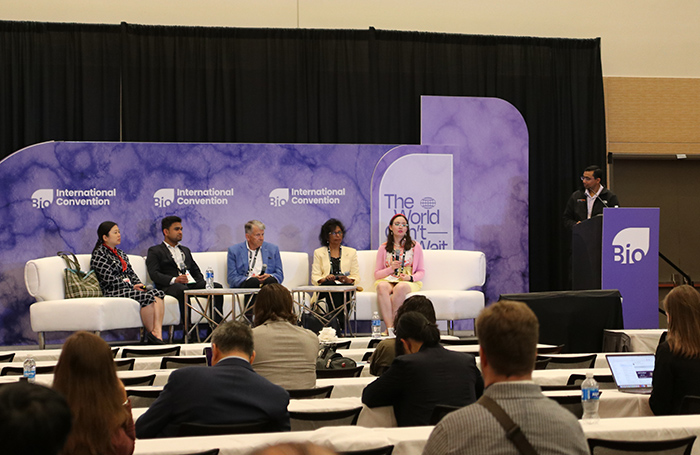The federal government’s program that provides seed funding to support research by biotech startups provides much more than money, said program officials and small biotechs at the 2025 Biotechnology Innovation Organization (BIO) International Convention.
Recipients of Small Business Innovation Research (SBIR) and Small Business Technology Transfer (STTR) grants can benefit from the SBIR Partnering program, as well.
As moderator Rupak Doshi, CEO of OmniSync, explained, SBIR seed funding channeled through the National Institutes of Health (NIH) catalyzes further investment. Investors know biotechs that pass NIH vetting have a good chance at success, so they are ready to back them, he explained.
“A decade ago, there was a survey by the NIH that showed more than 10% of all the SBIR-funded winners were able to successfully get to over $1 million in revenue, either through sales or licensing,” he said. “That may seem like it’s a small number, but actually, it’s a good percentage if you compare it to companies otherwise in the market that get to $1 million plus.”
With its track record of getting products to market, the SBIR is vital to progress in biotech. That’s why the Biotechnology Innovation Organization (BIO) is working hard to ensure that the program is reauthorized before it expires on Sept. 30. Legislation announced on May 1 would make SBIR/STTR permanent.
The benefits of SBIR/STTR
Two representatives of the National Heart, Lung, and Blood Institute’s (NHLBI) Small Business Partnering Platform explained how their platform can help by giving more than just funding. They touted the success of SBIR/STTR and its partnering platform, and encouraged biotech startups to take full advantage of the opportunities available.
“The purpose of the SBIR or STTR programs is to provide money that can de-risk technologies that are in line with the agency’s mission, and get them to a point where they not only can be commercialized, but also are more attractive to private investors,” said Stephanie Davis, Small Business Program Coordinator at the NHLBI Innovation and Commercialization Office.
“Although we do not buy the technology, we want to de-risk it to a point that the company essentially no longer needs our funding to develop the technology,” she explained.
Beyond financial support, the partnering program and its online platform can facilitate connections these companies, especially startups, need, according to Jain Krotz, Acting Director, Partnerships & Engagement Lead at the NHLBI Innovation and Commercialization Office.
“They may not have all the bandwidth, all the know-how on product development, and the expertise they need to bring the technology to late stage,” she said. “They might need a subject matter expert to have a discussion about what direction would be best.”
How SBIR/STTR helps small biotechs
“Once you have an SBIR grant, it does give you some level of credibility that the science is sound because it’s gone through a lot of peer-reviewed research and analysis,” said Prathamesh Prabhudesai, M.D., CEO of SafeBVM Corp, which successfully used SBIR funding.
Dr. Prabhudesai recalled seeking a university hospital system as a partner, but finding it challenging to break in until he sought advice from the platform and Krotz.
“I was a new investigator and I did not have the connections,” he explained. “As I was working and we were on the platform, I found out the university hospital system also has a venture arm, and it was very easy for me to just reach out to Jain and ask for an introduction, and now we have a chance to actively work with the partners through the right networks.”
Evan Unger, M.D., Chairman and Co-Founder of NuvOx Pharma, described successful exits from biotechs that started with SBIR money, including one for which he was able to raise $50 million before its sale. Simple things like support for participation in conferences made a difference for his companies. For example, a presentation at a conference brought in $1 million from an angel investor.
“I wouldn’t have attended that event without support,” Unger said. “Participating might cost $2,000 or $3,000. You know, for a development-stage company, that’s expensive. And it had a very good outcome.”
An investor promotes patients’ needs
Offering an investor’s perspective, Fei Shen, Managing Director of Boehringer Ingelheim’s U.S. Venture Fund, knows firms with SBIR and STTR backing can be taken seriously because they received NIH vetting before getting funded. The partnering platform is especially useful as it allows her team to look for the kinds of projects that interest them.
“We have a person regularly go on and search the platform, which is very systematically built. You can search for keywords. For example, regeneration is a very strong interest for us,” she said.
Boehringer Ingelheim is working to treat diabetes and lung conditions with regenerative medicine. Shen said they had an interest in partnering with startups working in this exciting field—particularly for solutions benefiting patients.
“We can provide early financial support, and we can do multiple follow-ons. We would not only continue providing money, but also our expertise from the research and development angle, to help a company spend the money on experiments that lead towards something meaningful for patients,” she said.
“Concepts that are commercial are nice, but we also need to focus on the patient to address medical need,” Shen explained. “I believe this is very much aligned with what everybody sitting here in the audience wants.”




